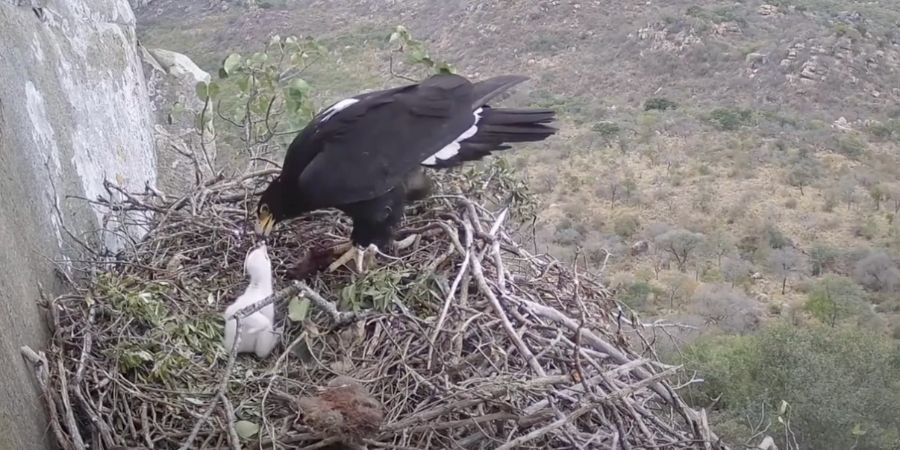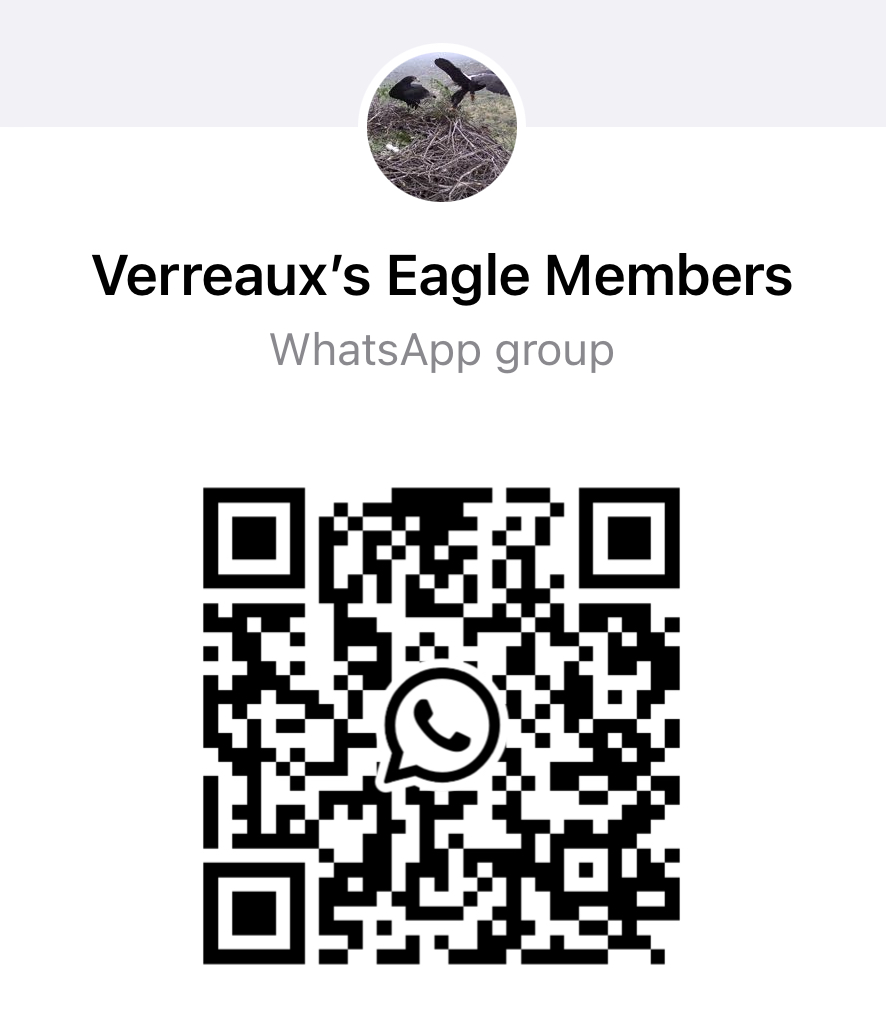

WELCOME TO SELATI'S VERREAUX'S EAGLE PROJECT
Welcome back to Selati’s Verreaux’s Eagle Project, now in its second year!
This unique conservation initiative not only employs cutting-edge live-streaming technology to provide unparalleled insights into the breeding behaviour of a pair of Verreaux’s Eagles within the Selati Game Reserve, but also plays a critical role in the conservation of these majestic raptors.
Last year, our live camera captured the full cycle of the eagles; nest building, egg laying, feeding of the remaining chick and eventually the successful fledging of the chick.
Verreaux’s Eagles typically breed once a year, raising one or occasionally two chicks. The breeding success of these eagles can vary, influenced by environmental factors and the challenges of chick-rearing. This year to deepen our understanding of these dynamics, we have installed a live-streaming infra-red camera system to hopefully further explore the behaviour at their nest during the night time hours. This setup documents their entire breeding cycle—from nest preparation to the fledgling’s first flight—while minimising disturbance to the birds.
Witnessing these magnificent eagles nurture new life is truly fascinating. We are excited to once again offer this exclusive window into the natural world to bird enthusiasts globally. Through our live camera feeds, viewers can observe the eagles and actively contribute to their conservation by joining the conversation. Viewers can also make donations to the Selati Wilderness Foundation.
Project Timeline: The project and live camera feeds will run through the end of the Verreaux’s Eagle breeding cycle, anticipated to conclude by the end of September when the fledgling leaves the nest.
For insights into our project’s inaugural year and the significant findings that have shaped our ongoing efforts, please visit https://selatiwf.org/verreauxs-eagles-selati/
📈 Eaglet Timeline
- Follow us here for updates
VIEW THE LIVE STREAM
We invite you to tune into our live stream below, offering a rare glimpse into the nest of the Verreaux’s Eagles, available daily.
If you have a burning question or an insightful observation about the Verreaux’s Eagles, we’re eager to hear from you. Whether you’re curious about their behaviour, habitat, our conservation efforts, or if you’ve made a fascinating observation while watching our live stream, feel free to share in the comments section of the YouTube livestream below. Your thoughts and insights greatly contribute to our community’s understanding and collective appreciation of these splendid birds.
We also invite you to consider making a donation to support the conservation of the Verreaux’s Eagles. More details about this can be found below on this page. Thank you for your generosity.
We appreciate your support!
Please note: Our live stream operates daily. In rare cases the stream may be temporarily unavailable due to technical reasons. If the stream is currently offline, we appreciate your patience and kindly ask you to check back soon while we restore the connection. Thank you for your understanding.
HIGHLIGHTS VIDEOS
Showcasing highlights from our Verreaux’s Eagle project, the videos below have been curated to offer an insider’s view of this exciting initiative. Dive in to understand the behind-the-scenes efforts that brought this project to life, as well as captivating moments from our Verreaux’s Eagle live stream.
HIGHLIGHTS PACKAGE 7 | WING FLAPPING
This highlight video consists of footage taken over a period of 2 weeks. It is exceptional to see how quickly this eaglet grows, as it learns to balance and stand. it is equally remarkable to see how the plumage of the chick develops at 2-4 day intervals between the clips.
The chick becomes more observant of its surroundings, taking in views from the height of the granite koppies – more often than not, keeping a watchful eye out for its parents and an incoming meal. The wing flapping exercises seen most prominently in the clips from 11, 15 and 18 August help the chick develop critical strength required for taking its first flight and becoming an independent eagle.
The video ends on 18 August where it’s clear that the chick has grown, taking on a lean looking body, comparative to its “fluff ball” state where the video begins on 3 August.
Commentary with thanks to Lucia Rodrigues.
More about Lucia:
My name is Lucia Rodrigues. My interest in Verreaux’s Eagles dates back to 2004 when I accidently stumbled across the Verreaux’s Eagle nest in Silvermine which falls within the greater Table Mountain National Park. This nest afforded me, with the aid of a spotting scope, the opportunity to closely monitor the daily activity at a nest. The pair nested at this site for well over a decade and has subsequently moved to a more remote cliff closer to Table Mountain, to take occupancy of nests that had not been in use since 2005.
Since those early years I have gradually expanded my search for other pairs, well off the peninsula, into the greater Western and Northern Cape. It is an activity that to this day still occupies my time during their breeding season. I have managed to build a significant data base of nests, some of which I visit regularly.
It is therefore with great delight that I have accepted the invitation to comment on the Selati pair, which find themselves in an environment I have not “worked” in before.
HIGHLIGHTS PACKAGE 6 | FEEDING
12 July
Remains of two Rock Hyrax on the nest and the female is feeding the young chick. She tears off a small piece and feeds it to the chick, which it easily swallows. The next bigger piece she keeps hold of allowing the chick to attempt at pulling pieces off by itself. She frequently retrieves the piece, either where it’s been dropped or from the chick’s beak as it struggles to swallow it, until the entire piece is consumed.
14 July
Remains of what looks like another Rock Hyrax on the nest. The female in the foreground, flies off and reveals the chick with a visibly distended crop. It has clearly just been well fed.
The chick moves forward and seems to topple over, bottoms up and squirts a substantial streak of white faeces onto and over the rim of the nest. This is one of the signs one looks for when trying to establish from afar whether the nest is “active” or not. Even fine white streaks are visible from afar using good quality optics.
24 July
Chick being fed small bites at a time at quite a brisk rate.
3 August
The first feathers are beginning to show. Four seconds into this video, amongst a flurry of huge black and white wings, both adults land on the nest. The female is carrying a fully grown Rock Hyrax which probably weighs 5 kgs. The female immediately mantles the prey, pushing aside the male. She does this to avoid the male trying to feed or fly off with it. After some “chatting” he takes the hint and flies off. The video shows him flying off into the distance and also circling back towards the nest. There does not seem to be an urgency to start feeding at the same rate as the previous video, so we can assume the chick is kept well fed. The female manoeuvres the carcass closer to the nest cup and it looks like she starts tearing into the flesh and provides the chick with a few tentative bites. The pair look up frequently and we can just wonder what they are looking at.
On the following day at 13h42, a small hole can clearly be seen on the egg. More leafy greens are brought onto the nest and at 15h18, the little hole has become a lot larger.
In the early morning of the 29th June, the egg is still intact and by 11h13 the male delivers the first prey item onto the nest. By now there is a very big opening in the egg. Generally speaking, prey on the nest indicates the presence of a chick. Very rarely have I witnessed Verreaux’s Eagles consuming prey on the nest well before a chick hatches. The male pops back onto the nest twice, once at 11h32 and then again at 12h30. The female responds by mantling the prey, to discourage the male from either feeding or removing the prey from the nest. She does however allow him some time later, to relieve her on the nest, while she presumably takes a short flight to stretch her wings.
Towards the end of the footage the female is seen dragging the prey to a more convenient position, tears into it to expose the red flesh. She does not feed.
Commentary with thanks to Lucia Rodrigues.
More about Lucia:
My name is Lucia Rodrigues. My interest in Verreaux’s Eagles dates back to 2004 when I accidently stumbled across the Verreaux’s Eagle nest in Silvermine which falls within the greater Table Mountain National Park. This nest afforded me, with the aid of a spotting scope, the opportunity to closely monitor the daily activity at a nest. The pair nested at this site for well over a decade and has subsequently moved to a more remote cliff closer to Table Mountain, to take occupancy of nests that had not been in use since 2005.
Since those early years I have gradually expanded my search for other pairs, well off the peninsula, into the greater Western and Northern Cape. It is an activity that to this day still occupies my time during their breeding season. I have managed to build a significant data base of nests, some of which I visit regularly.
It is therefore with great delight that I have accepted the invitation to comment on the Selati pair, which find themselves in an environment I have not “worked” in before.
HIGHLIGHTS PACKAGE 5
The video opens at 06h31 the next morning and the chick has hatched. The female starts feeding the chick tiny pieces of red flesh she picks off the carcass of the Rock Hyrax (dassie) and delicately places it in the tiny beak of the chick. Ten minutes later the chick is replete and the female settles down to brood the chick. Observe how she keeps her talons out of harm’s way as she settles down onto the chick.
Newly hatched chicks have a tiny “horn” on the top of their beaks, referred to as the “egg tooth”. This drops off within a day and is used by the chick to break itself out of the egg. As demonstrated, it is a long and arduous job. We spotted the tiny hole, on the afternoon of the 28th June and the chick probably hatched late on the 29th June. Research has shown that this “struggle” is essential for the proper development of the chick.
Commentary with thanks to Lucia Rodrigues.
More about Lucia:
My name is Lucia Rodrigues. My interest in Verreaux’s Eagles dates back to 2004 when I accidently stumbled across the Verreaux’s Eagle nest in Silvermine which falls within the greater Table Mountain National Park. This nest afforded me, with the aid of a spotting scope, the opportunity to closely monitor the daily activity at a nest. The pair nested at this site for well over a decade and has subsequently moved to a more remote cliff closer to Table Mountain, to take occupancy of nests that had not been in use since 2005.
Since those early years I have gradually expanded my search for other pairs, well off the peninsula, into the greater Western and Northern Cape. It is an activity that to this day still occupies my time during their breeding season. I have managed to build a significant data base of nests, some of which I visit regularly.
It is therefore with great delight that I have accepted the invitation to comment on the Selati pair, which find themselves in an environment I have not “worked” in before.
HIGHLIGHTS PACKAGE 4
Video captured at x2 speed
The video opens at 07h13 on the 26th June, with an incubating eagle on the nest, which I assume is the female.
She, and possibly the male as well, are on and off the nest frequently and as the afternoon wears on, fresh green sprays are brought onto the nest to form a deeper nest cup. It is thought that eagles carefully choose greenery that has parasite repellent properties in order to sanitise the nest cup, a habit of raptors in general.
By the next morning, more greenery is ferried onto the nest and I have the opportunity to properly see the egg and it’s not cracked. Nest cup refurbishment is still underway into the late afternoon and because we are expecting the chick to hatch any day now, it’s obvious the adults are aware of this and preparing the nest for this event.
8 August 9h54
As in the previous video, the adults fly in, the female a little ahead of the male this time, carrying, what looks like the remains of what I guess, is a Rock Hyrax. As she lands, she immediately mantles the prey and stays in this position until the male leaves. It’s noticeable that she watches the male as he flies off into the distance and she also calls continually.
8 August 10h00
The female starts tearing into what looks like the pelt of the prey, eating some herself as well as feeding bits to her chick. The chick valiantly tries to swallow a large piece of pelt, but needs the female to intervene and assist in pulling off smaller pieces for it to swallow. One may wonder why the adults returned with only the pelt. Often the adults first feed on prey caught and bring remains to the nest for the chick. Another possibility is that it could have been scavenged.
10 August
Two days later we see the chick on the nest by itself, beginning to feed from prey left conveniently opened up for ease of access.
11 August
We see the chick standing up and bracing itself against the rock face as two eagles, each with two meter wingspans land on the nest. Female ahead of the male, clutching a Rock Hyrax. Next a routine we have become familiar with, female mantles prey and male flies onto a small ledge nearby, where he scrapes his beak against the rocky surface, which leads me to believe he might have been feeding on the prey before it was delivered onto the nest. Before feeding in earnest gets underway, the 6 week old chick hops about, stretches and flaps its wings. The first time we have observed this and will occur more often going forward.
14 August
Video opens with the chick on the nest and no prey visible. 30 seconds later, a lovely shot of both eagles flying in from a distance. Once again female carrying a Rock Hyrax, ahead of the male in hot pursuit and calling. Female mantles the prey and the male, still calling, gets the message and flies off. We notice again that the female has an exposed “white” feather on the edge of her left wing. In a previous video (03/08) one can clearly see when she lands on the nest, that a primary feather is missing. She could be moulting or had a little accident which resulted in her losing a feather. Feeding starts pretty promptly.
15 August
We see the chick standing more often and it seems to be looking out for the adults. There is no prey on the nest. The chick backs up against the rock face and we expect to see the adults any minute. And they do, the female arrives ahead of the male, carrying a Rock Hyrax. It’s obvious that there is no shortage of the prey Verreaux’s Eagles have become associated with. Female mantles the prey and we notice the chick now imitates this behaviour and does the same. Female calls continually and the male flies off. Chick shows an interest in the prey and the female prepares to start feeding it, but not before the chick executes a few hops and wing flaps.
Commentary with thanks to Lucia Rodrigues.
More about Lucia:
My name is Lucia Rodrigues. My interest in Verreaux’s Eagles dates back to 2004 when I accidently stumbled across the Verreaux’s Eagle nest in Silvermine which falls within the greater Table Mountain National Park. This nest afforded me, with the aid of a spotting scope, the opportunity to closely monitor the daily activity at a nest. The pair nested at this site for well over a decade and has subsequently moved to a more remote cliff closer to Table Mountain, to take occupancy of nests that had not been in use since 2005.
Since those early years I have gradually expanded my search for other pairs, well off the peninsula, into the greater Western and Northern Cape. It is an activity that to this day still occupies my time during their breeding season. I have managed to build a significant data base of nests, some of which I visit regularly.
It is therefore with great delight that I have accepted the invitation to comment on the Selati pair, which find themselves in an environment I have not “worked” in before.
HIGHLIGHTS PACKAGE 3
This video opens at 6h29 on the 6th June and as expected an adult is sitting tight on the nest. When the adult stands up, only one egg is visible and it is clearly cracked, which is surprising because it’s not due to hatch until about 45 days after laying. About 90 minutes later the second egg appears on the screen and it’s difficult to understand why it wasn’t visible earlier. As the adult settles down again to resume incubation, she clearly appears to favour the cracked egg, because the 2nd egg, lies openly next to her. This is all very puzzling and also the last time we see two eggs on the nest. The adult frequently buries her head into the nest cup, below the egg. At 16h20 I can confirm it’s the cracked egg that she is still incubating. It’s very likely one of the eagles’ accidentally nicked the egg with its claw. This can easily happen when both adults are on the nest.
I have however observed how careful the female is when she moves around the nest. More often than not, she curls her claws in. Those who have observed eagles mating, might also wonder about the males’ claws. He curls them in as well.
During the afternoon the male and female frequently change places on the nest, which is normal behaviour. Generally speaking, the female does most of the incubating, although this does differ between pairs. I have discovered over the years that eagles, like humans, have different personalities. This might be due to their age. Young eagles still have a lot to learn and can make mistakes, or not fully realise the responsibilities of their role.
An example of this comes to mind. During my years of watching the Silvermine nest, a new male had taken up residence with the older female. I could tell it was a younger bird by the faint sprinkling of small brown feathers. Female on the nest, brooding a tiny chick of a few days old and as the day wore on well into the afternoon, I was becoming concerned that there was no food on the nest and no sign of the male, whose responsibility it is during these early days to hunt and bring food back onto the nest. Eventually he turns up, clutching a small prey item, but instead of bringing it onto the nest, sails past and off into the distance. In a flash the female is up and chases him down, grabs the food from him and carries it back onto the nest. I am convinced this was his first breeding season and a lesson well learnt because I did not witness this behaviour again.
Commentary with thanks to Lucia Rodrigues.
More about Lucia:
My name is Lucia Rodrigues. My interest in Verreaux’s Eagles dates back to 2004 when I accidently stumbled across the Verreaux’s Eagle nest in Silvermine which falls within the greater Table Mountain National Park. This nest afforded me, with the aid of a spotting scope, the opportunity to closely monitor the daily activity at a nest. The pair nested at this site for well over a decade and has subsequently moved to a more remote cliff closer to Table Mountain, to take occupancy of nests that had not been in use since 2005.
Since those early years I have gradually expanded my search for other pairs, well off the peninsula, into the greater Western and Northern Cape. It is an activity that to this day still occupies my time during their breeding season. I have managed to build a significant data base of nests, some of which I visit regularly.
It is therefore with great delight that I have accepted the invitation to comment on the Selati pair, which find themselves in an environment I have not “worked” in before.
HIGHLIGHTS PACKAGE 2
15th May, an auspicious day because we can track exactly when the first egg was laid.
Most of the morning is spent constructing a deep nest cup, with both male and female ferrying a variety of green sprays onto the nest. One also notices how the nest rim facing away from the cliff is built up. This provides shelter for the small chick, as well as cover to remain out of sight from below.
The industrious pair are on and off the nest until midday, when there’s an hours break in activity, with no eagles on the nest.
Shortly after one o’ clock the female is back on the nest. More nest cup material is brought onto the nest. Light rain sets in and she hunkers down.
A heartbeat after 3 o’clock the first egg appears. We can now be pretty sure that it’s the first egg that hatched 45/46 days later.
Friday 19th May dawns misty with the female on the nest. About 90 minutes later, she stands up and reveals that there are now two eggs. At 7h53 a second eagle lands on the nest and it looks like the male takes over incubation. The weather starts clearing and the female is back on the nest at 9h11 to take over incubation. Shortly after, the male arrives with yet more foliage for the nest cup and this more or less, describes the activity for the rest of the day. Frequent incubation changes and ferrying green sprays onto the nest to keep the cup fresh and soft.
The general rule is that 2 eggs are laid 3 to 4 days apart and only one chick survives. The older and stronger chick being fed most of food brought onto the nest, second chick becoming weaker and easily succumbs to the bullying by its sibling as well as the deliberate neglect by the female. The neglect by the female shocked me when I first observed this behaviour at the Silvermine nest, until I realised that she has survived to become part of the breeding population by doing exactly the same.
There are times however when only one egg is laid. I have observed this twice at two different nests and on both occasions those single eggs hatched. Why this sometimes happens is not clear and one can only speculate about the possible reasons.
The video ends at 17h42.
Commentary with thanks to Lucia Rodrigues.
More about Lucia:
My name is Lucia Rodrigues. My interest in Verreaux’s Eagles dates back to 2004 when I accidently stumbled across the Verreaux’s Eagle nest in Silvermine which falls within the greater Table Mountain National Park. This nest afforded me, with the aid of a spotting scope, the opportunity to closely monitor the daily activity at a nest. The pair nested at this site for well over a decade and has subsequently moved to a more remote cliff closer to Table Mountain, to take occupancy of nests that had not been in use since 2005.
Since those early years I have gradually expanded my search for other pairs, well off the peninsula, into the greater Western and Northern Cape. It is an activity that to this day still occupies my time during their breeding season. I have managed to build a significant data base of nests, some of which I visit regularly.
It is therefore with great delight that I have accepted the invitation to comment on the Selati pair, which find themselves in an environment I have not “worked” in before.
HIGHLIGHTS VIDEO 1 | CAMERA SETUP AT THE NEST
Welcome back to Selati’s Verreaux’s Eagle Project, now in its second year! Watch this video for a behind-the-scenes look at our Selati Research team as they return to the nest site to install a brand new infra-red camera and ensure all the equipment is in working order and ready for streaming. This year, to deepen our understanding of these majestic birds, we have installed a live-streaming infra-red camera system to explore their behaviour at the nest during night-time hours.
In this video you are able to get an idea of the sheer size of the Verreaux’s Eagle nest as Steve abseils down the cliff-face & stands alongside it! Verreaux’s Eagle nests are platform nests made up of large sticks, lined with green leaves – which intensifies closer to the laying date. The nests can span up to 2.5m wide and 4m deep, depending on how old they are, and are built by both parents which can take between 6 weeks to 4 months. They are almost always placed on steep, inaccessible cliff faces.
Video with thanks to Matt Niederer.
HIGHLIGHTS PACKAGE 1A
On 26 January 2023 the Selati Wilderness Foundation set off on a mission to install a non-invasive, live camera above the nest of a pair of Verreaux’s Eagles.
This required the skill of the Selati Research team who pulled together both a ground and air team to orchestrate the task.
Fighting immense winds and a bit of rain – solar panels, batteries, cables, abseiling ropes and other necessary equipment were delivered to the ground team via helicopter, atop the crest of the Lillie Koppies on Selati Game Reserve.
Selati Game Reserve’s Wildlife Manager, Steve Seager, abseiled down the koppies to access the nest site and begin setup.
After a few technical challenges, we successfully got the live stream camera up and running and are proud to be able to offer this live footage and highlights packages to our project members.
Helicopter Pilot: Gerry McDonald (Big Game Heli)
Ground Team: Selati Wilderness Foundation Board Member Garth Batchelor, Selati Research Team and Volunteers
JOIN OUR VERREAUX'S EAGLE WHATSAPP GROUP
Opt in and join our WhatsApp group for members. You will receive instant notifications from our research team on the ground so you’ll never miss an interesting moment at the nest site.
Scan the QR code via your mobile phone's QR scanner app >
Alternatively click on this link to join the group.
Don’t miss the chance to learn more about these fascinating birds, and help them survive and thrive in their natural habitat.

MAKE A DONATION
Please support us by making a donation below. Your contribution will play a vital role in supporting our conservation efforts.
The proceeds from contributions will go to the Selati Wilderness Foundation NPC and will be deployed to further the conservation objectives of the organisation. Your contribution will go a long way towards protecting Verreaux’s Eagles and other endangered species on the Selati Game Reserve.
To make an online donation with via our secure online payment gateway (Payfast), complete the form below. Under our list of beneficiaries, please select ‘Verreaux’s Eagle Project’. Alternatively, please support our project on GivenGain.
Donate
DONATE VIA GIVENGAIN
Disclaimer
While it is the intention to run this project for the duration of the Verreaux’s Eagle breeding cycle, the project is being conducted in the wild and there are a number of factors that could come into play that could result in early termination. These include inter alia damage to the equipment and/or nest due to weather or animals (elephant) or the birds abandoning the nest. We regret to advise that donations made will not be eligible for a refund in the event of an early termination.
THANK YOU FOR YOUR SUPPORT!




